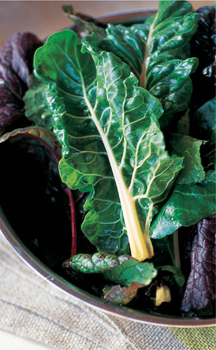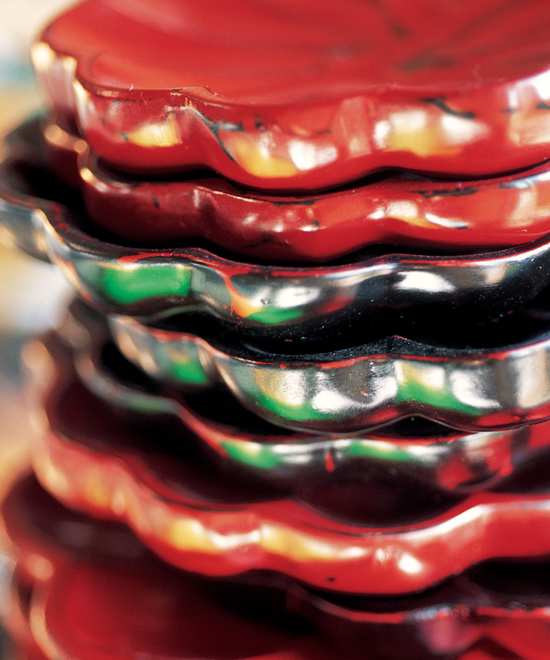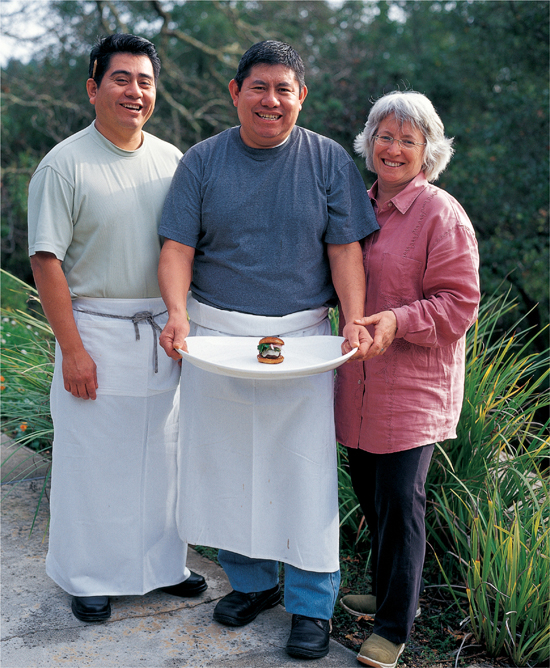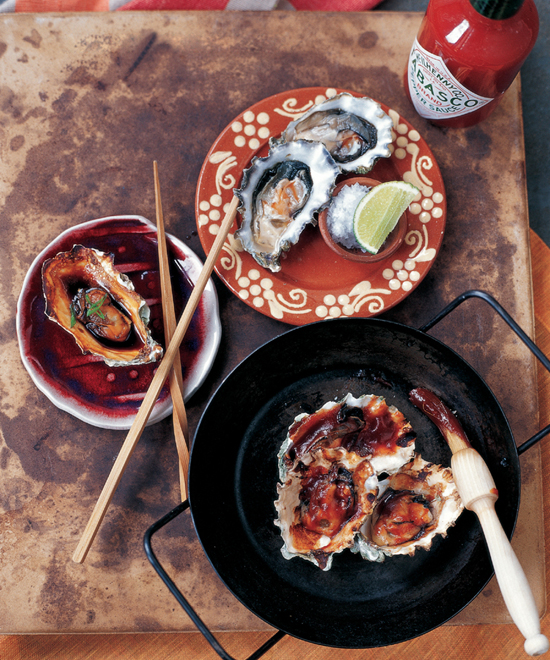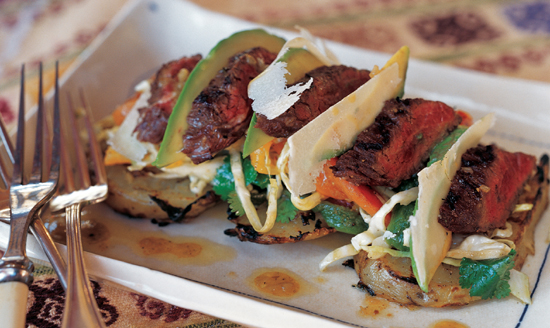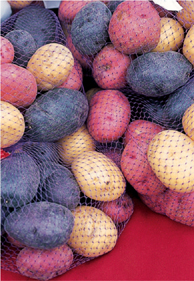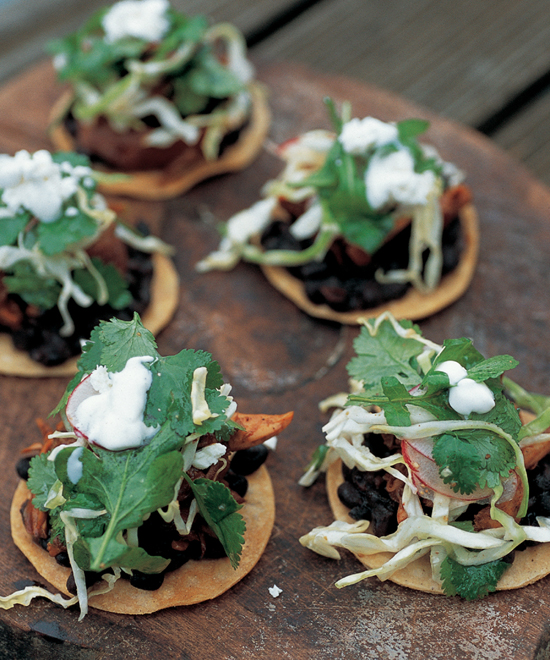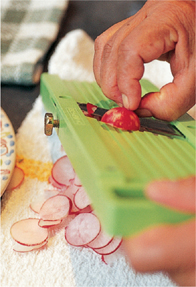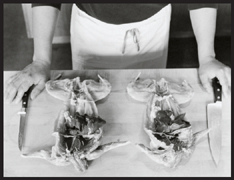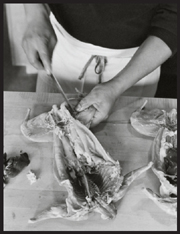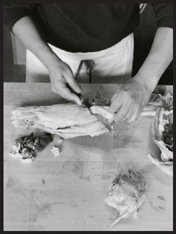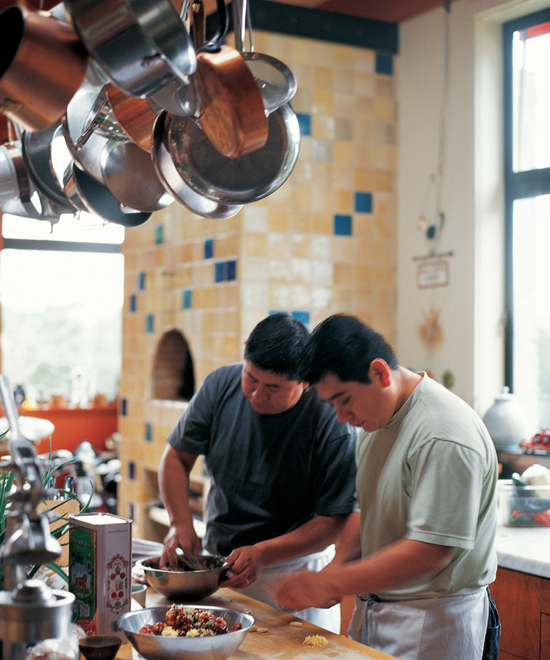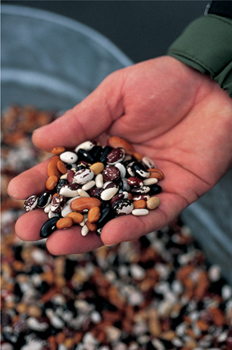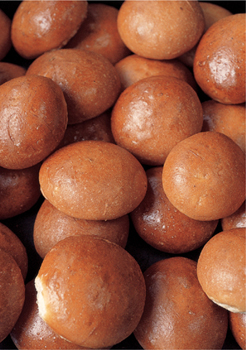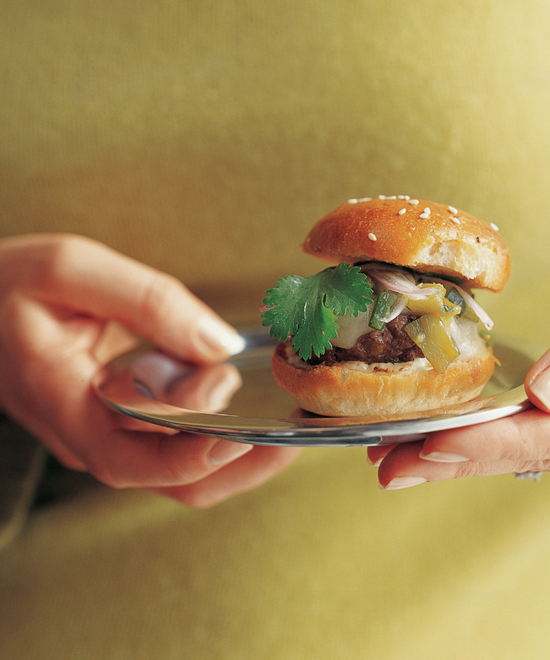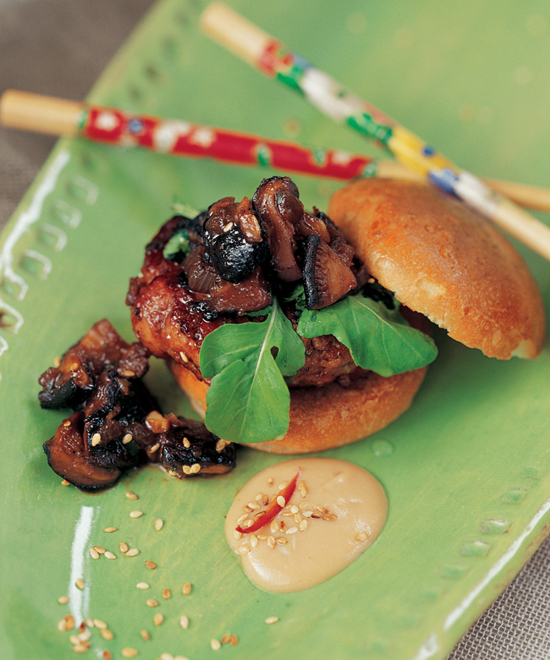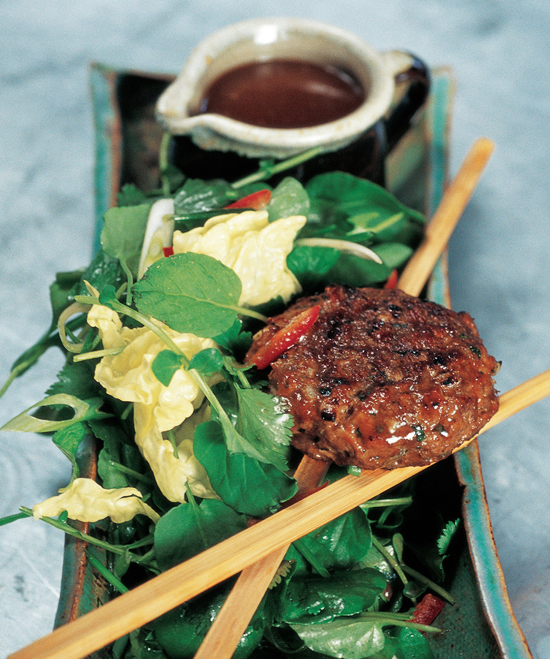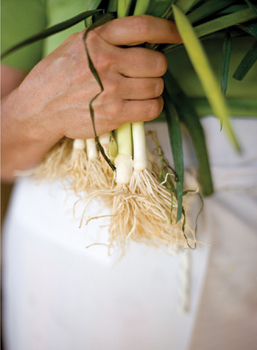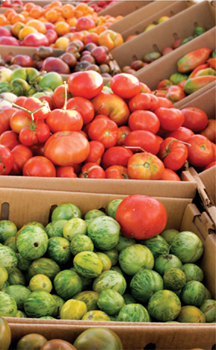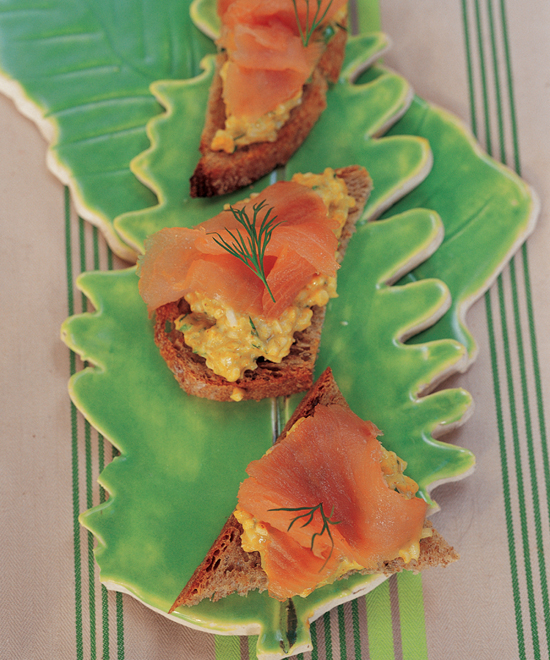chapter 4: On a Raft
In old diner lingo, if something came “on a raft,” it meant the food was served up on toast. We’ve stretched the raft concept a bit in this chapter to include buns (for a selection of burgers) and tortillas (for an assortment of tostadas), plus oyster shells, and a potato raft, too. (This last dish, Grilled Beef on Potato Rafts with Salpicón, looks especially nice served on a long oval platter, with the rafts all lined up alongside each other. One night I made these for my boyfriend, Marshall, and he was really impressed. I should sell that recipe to a matchmaking company, it worked so well.)
Serving food on rafts cuts down on dishwashing, my least favorite part of cooking. Eating can get messy, though, so put out plenty of napkins! Use these recipes as guidelines and have fun creating rafts of your own.
In old diner lingo, if something came “on a raft,” it meant the food was served up on toast …. Serving food on rafts cuts down on dishwashing, my least favorite part of cooking.
Serves 6
Many years ago, I opened a restaurant in an alleyway in San Francisco’s financial district. It was called Bix, and it was an elegant supper club, a cool place, and cool people went there—still do. Gérard Depardieu once kissed my hand there! Gordon Drysdale was the chef and Doug “Bix” Biederbeck, my partner in this venture, worked the front of the house. Doug was the one who had a clear vision of what the restaurant should be: a speakeasy with updated, hip, tasty food, like Bix Steak Tartare, for example. It’s still on the menu, and I believe it’s as good as any steak tartare you could get anywhere, including Paris.
In recent times people have become squeamish about raw eggs and meat. I use very fresh meat from a reputable butcher and mince it myself—so I know it’s freshly done. You can also purchase bottled mayonnaise or pasteurized eggs.
This is pretty much a do-it-yourself affair. I like to set out all the garnishes and condiments so people can mix and season to their own tastes. Have Maldon flake salt available, if you can. This salt comes from England, and it’s my very favorite sea salt. The salt crystals are lacy, papery flakes that dissolve very quickly. In cold dishes, they add a tiny bit of crunch without overwhelming you with saltiness. You can use mayonnaise or aioli as a substitute for the egg yolks. Oh, and a vodka martini, shaken, not stirred, is the ideal mood setter.
18 thin slices rye or sourdough bread
Olive oil, for coating
12 ounces beef tenderloin
6 quail eggs, 3 chicken eggs, or 3 tablespoons homemade mayonnaise or aioli
3 tablespoons finely minced cornichons
½ bunch parsley, leaves only, finely minced, then rinsed and squeezed dry in a towel
3 tablespoons minced green peppercorns
3 tablespoons capers, rinsed and minced
3 to 4 tablespoons minced anchovy fillets
Worcestershire sauce
Dijon mustard
Pickapeppa or Tabasco sauce
Salt and freshly ground black pepper
, preheat the oven to 375°F. Coat each side of the bread with oil and bake until crisp, 7 to 11 minutes.
, remove any tough sinewy pieces, and trim off a bit of the fat but not all of it. Finely mince the beef using a sharp cleaver. I have done this with a food processor, too, which is almost as good. Just be sure it has a sharp blade, and do it in small batches, pulsing it on and off. Do not grind the meat in a meat grinder, as this will result in an unpleasant texture.
Mound the beef in the center of a serving plate, and make an indentation in the top of the mound with the back of a spoon. Separate the eggs, and carefully place the yolks in the indentation (save the whites for some other use). If you’re using mayonnaise or aioli, spoon it into the indentation instead. Arrange the croutons on one side of the plate, and on the other, arrange the cornichons, parsley, peppercorns, capers, and anchovies in individual piles. Set out the Worcestershire sauce, Dijon mustard, hot sauce, salt, and pepper. Let your guests mix the condiments into the beef as they like.
, here’s a neat serving option. Make 6 burger-shaped patties of the diced meat and place them on individual plates. Using a knife, make crosshatch marks on the surface of the patties, then make a small indentation in the center of each patty. Separate the eggs, and place a yolk in each little hollow. Arrange the garnishes and toasts around each patty. You can do this with yolks from chicken eggs, too, but then you’ll need to break the yolks and stir them up before spooning some into the center of each patty.
Put freshly chopped parsley in a kitchen towel and twist it shut; run it under cold water and then squeeze dry. This releases the extra chlorophyll and makes the parsley taste sweeter and less grassy. I don’t do this with any other fresh herb, but almost always with parsley.
Grilled Oysters—Easy as Pie
Grilled Oysters—Easy as Pie
Serves 6
Here’s a great trick for keeping your guests busy while you pull the rest of the meal together. Set out a tray of freshly shucked oysters and let them grill up the oysters themselves. They can help themselves to the mix-and-match sauces and eat the oysters hot off the grill. Offer a choice of a spicy-hot barbecue sauce and a citrus-soy sauce, or some people may opt for seasoning their oysters as they do in Mexico, with a squeeze of lime juice, a couple of shakes of Tabasco sauce, and a sprinkle of salt and pepper.
For the most part, we get our oysters from a local concern, the Hog Island Oyster Company. Wherever you are, you’ll need to find a good supplier nearby (or consider ordering by mail if you live inland). There are many varieties of oysters available now. Have fun—try different kinds. Just keep in mind a couple of general rules: the larger oysters are better for cooking and the smaller ones are better for eating raw. And if a raw oyster doesn’t smell good, throw it out! If you are not into shucking oysters, just give them a good scrub beforehand. Put the whole oysters on the grill to cook, and they’ll automatically pop open when they’re done. Discard any that do not open when cooked.
½ cup barbecue sauce (your favorite brand)
½ cup freshly squeezed lemon juice
1 tablespoon Worcestershire sauce
1 teaspoon freshly ground black pepper
Tiny pinch of cayenne pepper
4 tablespoons tamari
2 tablespoons freshly squeezed lime juice
18 to 24 fresh oysters
Tabasco sauce
Lime wedges
Fine sea salt
Additional freshly ground black pepper
, combine all the ingredients in a small saucepan. Bring this mixture just to a boil, remove from the heat, and reserve in the pan. You will need to reheat this sauce before serving and, when you do, try to time it so it is hot just as the oysters are coming off the grill.
, combine the tamari and the lime juice in a squirt bottle and shake well.
Carefully shuck the oysters, leaving each oyster and as much of its juices as possible in the cupped bottom shell. To grill, place the oysters over a hot fire and cook until the juice in the shells gets bubbly and the edges of the oysters are just beginning to curl, 30 seconds to 1 minute. Take care not to overcook them: you want a bit of the natural juices left around the oysters when you pull them off the grill.
Reheat the barbecue sauce if necessary and set it out, along with the squeeze bottle of Soy-Lime Sauce (give it a good shake) and the Tabasco sauce, lime wedges, salt, and pepper. Dressing the oysters is a do-it-yourself thing that should be done while the oysters are still hot—or while they’re still on the grill, just before you pull them off.
Braised Portobello and Porcini Mushrooms with Spiced Flatbread
Braised Portobello and Porcini Mushrooms with Spiced Flatbread
Serves 6
These flatbreads are very crispy and crackerlike. They’re as light as air, yet sturdy enough to support a generous topping of braised mushrooms, or whatever else you have in mind. When making the flatbread dough, be sure to grind the cumin seeds and black peppercorns very finely, otherwise the dough might tear when you roll it out. A perforated baking sheet is preferred for baking, because it will give you better heat circulation and a more evenly cooked flatbread, but a flat baking sheet or a pizza stone would also work. Keep a close eye on the breads as they’re baking: they’ll seem to be taking forever, and then all of a sudden they’re done. You may burn one or two before you get the hang of it. The flatbreads will keep several days: wrap them well in plastic wrap, otherwise they’ll get soggy.
The mushrooms can be prepared a couple of hours ahead; then the dish will be a snap to finish.
1 cup flour
½ cup masa harina
½ teaspoon finely ground toasted cumin seeds
½ teaspoon salt
½ teaspoon finely ground black pepper
½ cup plus about 2 tablespoons water, as needed
1 ounce dried porcini mushrooms
3 tablespoons olive oil
1 tablespoon butter
4 large portobello mushrooms, stemmed and cut into bite-size pieces
1 or 2 cloves garlic, smashed
¼ teaspoon sea salt
⅛ teaspoon freshly ground black pepper
1 heaping tablespoon finely chopped fresh basil or marjoram leaves
Juice of ½ lemon
½ cup mascarpone cheese or fromage blanc
¼ to ½ cup finely shredded Parmesan cheese
, combine the flour, masa harina, cumin seeds, salt, and pepper in a large bowl and mix well. Work in the water a little at a time, using only as much as you need to make the dough come together. It should be moist to the touch but not sticky. Cover the bowl with plastic wrap or a damp towel and let the dough rest at room temperature 30 minutes. If you want to hold it longer, refrigerate it.
, preheat the oven to 425°F. Place a perforated baking sheet or a baking stone in the oven and let it heat through while you roll out the dough. Lightly dust a work surface with flour. Divide the dough into 8 equal pieces and roll each into a paper-thin round, stacking the finished rounds with parchment paper between to keep them from sticking. The rounds should be about 7 to 8 inches in diameter. If you have a large enough baking stone, or 2 perforated pans, you can bake 2 breads at once. But the baking goes quickly—1½ to 2 minutes for each—so it’s not that important. Bake until golden brown and crispy, turning the bread several times.
, place them in a small pot and pour in just enough very hot water to cover them. Soak 20 to 30 minutes, until soft. When soft, scoop out the porcinis and pat them dry with a kitchen towel or paper towel. Cut any large mushrooms into bite-size pieces. Slowly pour the soaking water through a fine mesh strainer into a container. Discard the sediment and reserve the soaking liquid. To finish, heat the oil and butter in a large sauté pan over medium-high heat. When the butter turns frothy, add the porcinis and portobellos. Sauté for several minutes, until the mushrooms have begun to caramelize. Add the garlic and cook 30 seconds to 1 minute more, until it is aromatic but not yet beginning to caramelize. Add the mushroom soaking liquid and the salt, pepper, basil, and lemon juice; simmer until reduced enough so that the juices just coat the mushrooms. They should be almost dry.
, preheat the oven to 425°F. Smear the flatbreads gently with the mascarpone or fromage blanc, sprinkle with the mushrooms and the Parmesan, and bake 3 to 5 minutes, until the mushrooms are heated through and the cheese is hot and light brown. If desired, a drizzle of romesco sauce would be a fabulous final touch. Serve immediately.
VARIATIONS
• Instead of the mushrooms, sprinkle the flatbreads with one or two cheeses of your desire, plus whatever happens to be in the fridge, such as some caramelized or roasted onions and/or garlic, and some sun-dried tomatoes or roasted tomato slices. Bake as described and serve.
• You can substitute semolina flour for the masa harina in the flatbread. Semolina, which is a wheat flour, will result in a more “Mediterranean” flavor as opposed to the “Latin” taste of the flatbreads made with masa harina.
Grilled Beef on Potato Rafts with Salpicón
Grilled Beef on Potato Rafts with Salpicón
Serves 6
“Stacked” food makes me cringe most of the time—it’s an overdone, outdated setup that makes food hard to eat, and after one bite, the precarious tower of food usually looks very unattractive. But this dish is gently constructed, and “stacking” seems to work here. The base is a sturdy slab of grilled potato that’s followed by a layer of somewhat spicy grilled beef and topped by the great salpicón. And voilà! A balanced meal in two bites.
So what is a salpicón? Most often it’s a salad or marinated vegetable slaw that includes finely sliced sweet onion or scallions, sweet bell pepper in a variety of colors, chiles usually, and sometimes finely shredded cabbage. It is often served with crabmeat, shrimp, or beef, and I did find one reference to quinoa. It must have come to the New World from Spain, though this would have to have been after we sent them peppers. I’ve found recipes in Spanish cookbooks, Mexican cookbooks, and South American cookbooks.
If you prefer a less spicy marinade, remove the seeds from the serrano chiles before mincing them. If you can’t find hanger steak, you could substitute flank steak. Allow at least two hours, and up to one day, for the meat to marinate. When buying the potatoes, keep in mind that you want six half-inch-thick slices, each about two bites long. Yukon Gold potatoes work well. You could even try sweet potatoes.
Another great presentation for this dish is to serve it in butter lettuce leaves rather than on the potato rafts. For this, cut the meat and potatoes into tiny dice or julienne them, scoop some of each into the lettuce cups, and top with a small amount of the salpicón.
2 cloves garlic, minced
2 serrano chiles, minced
2 to 3 tablespoons Worcestershire sauce
Zest and juice of 1 lime
2 to 3 tablespoons olive or vegetable oil
6 to 8 ounces hanger steak or flank steak
Salt and freshly ground black pepper
4 tablespoons sherry vinegar
1½ teaspoons Dijon mustard
2 shallots, minced
1½ teaspoons ground toasted cumin seeds
¼ teaspoon salt
⅛ teaspoon freshly ground black pepper
½ cup pure olive oil
¼ cup extra virgin olive oil
6 half-inch-thick slices potato
Olive oil, for coating
Salt and freshly ground black pepper
1 cup finely shredded cabbage
6 sprigs cilantro
½ roasted pasilla chile, peeled and cut into strips
½ large roasted red bell pepper, peeled and cut into strips
6 slices avocado
12 to 18 small pieces shaved Asiago cheese
Put all the marinade ingredients in a sealable plastic bag large enough to hold the meat. Mix well and set it aside. Pin the steak with a handheld
Jaccard tenderizing machine, if desired. Season the meat with salt and pepper and place it in the bag of marinade, making sure that all surfaces get nicely coated. Seal the bag, squishing all the air out as you go, and put it in the fridge at least 2 hours and up to 24 hours before grilling. Be sure not to leave the meat in the marinade any longer than 24 hours, or the marinade will “cook” the meat and you will not be able to prepare it rare.
, combine the vinegar, mustard, shallots, cumin, salt, and pepper in a medium-size bowl and stir until the salt has dissolved. Add the olive oils in a slow steady stream, whisking as you go. Continue whisking until well emulsified. Reserve until needed.
Steam the potatoes until fork-tender, about 6 or 7 minutes (older potatoes may take a little longer, so be sure to check). For the grilling, rub the potatoes with olive oil, sprinkle them with salt and pepper, and set them aside. Grill the steak over a medium-hot fire to the desired doneness, about 2 minutes per side for rare. Rotate the meat a quarter turn halfway through cooking on each side to get nice crosshatch grill marks. Let the meat rest while you grill the potatoes, also rotating them a quarter turn on each side to get nice grill marks. Remove the potatoes to a platter and keep them warm. Slice the steak on a slight angle into 12 pieces, saving any meat juices you can.
Combine the cabbage, cilantro, chile, and bell pepper, and dress lightly with some of the salpicón dressing. Lightly dress the potatoes, too, and arrange them on a serving platter. Top each slice of potato with 2 slices of steak, and drizzle with the reserved meat juices. Top with a little mound of salpicón and another drizzle of dressing. Add a slice of avocado and 2 to 3 pieces of Asiago to finish.
Serves 6
Whether you call them coquilles or scallops, these rich, sweet seafood delicacies should never be overcooked or they’ll become tough and chewy. There are a number of steps you can take to avoid this disaster when you fix this dish. First of all, assemble all the ingredients and paraphernalia that you’ll need ahead of time, including tongs to turn the scallops and a warmed plate to hold them after you’ve pan-seared them. Actually, you need two plates. My trick for holding the scallops is to invert the warmed plate and set it on a larger plate. After the scallops have been seared, they go on the inverted plate and onto a warming shelf or into a very low oven. Any excess juices will drain down, and the scallops won’t lose their crispy caramelized edges.
Once you’re ready to go, start making the sauce, set it aside for a moment while you sear the scallops and transfer them to the plate, and then finish the sauce. You’ll probably be done in less than seven minutes. If you overcrowd the pan, they’ll steam and overcook, so cook them in two batches or two pans.
3 tablespoons butter
2 tablespoons olive oil
1 tablespoon chopped garlic
3 beefsteak tomatoes, peeled, seeded, and sliced into wedges
½ cup white wine
Grated zest of ½ lemon
Juice of 1 lemon
Salt and freshly ground black pepper
1½ pounds sea scallops
3 or 4 leaves fresh basil cut into a chiffonade, plus some small leaves for garnish
¼ cup (loosely packed) chopped fresh Italian parsley, leaves and tender stems only
1 cup tiny croutons (¼-inch dice)
, put half the butter in a saucepan with enough olive oil to coat the pan nicely, and heat over medium heat. Add the garlic; sauté 1 minute, but do not let the garlic brown. Add the tomatoes and cook 2 minutes, or until the tomatoes exude some of their juices. Continue cooking until most of the liquid has evaporated. Throw in the wine, lemon zest, and lemon juice, season with salt and pepper, and let reduce a bit, about 3 minutes, until it is fairly thick.
, coat 1 large or 2 medium sauté pans liberally with the remaining olive oil and set them over high heat. Sprinkle a little salt and pepper on the scallops. When the pans are very hot, add a small amount of the remaining butter and put the scallops flat in the pan. Cook 1 minute, until golden brown on the bottom; turn them, using tongs, and cook another minute, until golden brown on the other side. (Keep an eye on the sauce while you’re doing this, and take it off heat if it’s done before the scallops.) Transfer the scallops to the warmed plate.
, return it to the heat. Add any liquid that has drained from the scallops, and stir in the basil chiffonade and half the parsley.
, put a spoonful or so of sauce on each plate, and place a few scallops on top. Sprinkle with croutons, small basil leaves, and the remaining parsley.
Rabbit Tostadas with Cumin-Scented Black Beans and Lime Crème Fraîche
Rabbit Tostadas with Cumin-Scented Black Beans and Lime Crème Fraîche
Serves 6
A lot of our regular customers at Cindy’s Backstreet Kitchen order this every time they come in and never try anything else. Though this recipe is fairly complicated, you can do almost everything ahead of time and have very little to do once the guests arrive. In fact, you could even have them assemble their own tostadas.
Check the recipe out carefully and figure out your own time line. Just consider that the beans need to soak overnight and will take about an hour to cook after that. The chiles for the chile paste need to soak for an hour, and you need to make the chile paste before you cook the rabbit. You can work the other parts of the recipe in around the beans and the rabbit. If rabbit is not to your liking, this dish could also be made with chicken thighs or turkey legs. And if cooking the beans seems like too much trouble, you can use canned black beans instead (see the note following the Cumin-Scented Black Beans recipe).
One of the key flavor components in this recipe is the guajillo
chiles. They are rust-colored, about four inches long and an inch and a half wide, a little fruity, and only mildly hot. Guajillos
are so common in California, all Latin American markets carry them, and you might even find them in some regular markets, too. You need five of them altogether, four for the rabbit and another for the black beans. There’s a hefty amount of ground cumin called for—5½
teaspoons in all—so you might find it easiest to toast and grind enough seeds for the whole recipe all at once. Cumin has strong flavors, so start with a bit less than called for, and add to your taste.
4 dried guajillo chiles, stemmed and seeded
2 cloves garlic
1 tablespoon fresh oregano leaves
½ tablespoon ground toasted cumin seeds
½ teaspoon salt
¼ teaspoon freshly ground black pepper
2 to 4 tablespoons olive oil
2 rabbits, cut into 6 to 8 pieces each
½ teaspoon salt
¼ teaspoon freshly ground black pepper
½ cup chopped celery
½ cup chopped peeled carrot
½ cup chopped onion
Rabbit or chicken stock (you’ll need about 3 to 4 cups; use some water if you don’t have enough stock)
1 cup crème fraîche
Finely grated zest of 1 lime
1½ to 2 tablespoons freshly squeezed lime juice
Tiny pinch of salt
A few grindings of black pepper
Peanut or vegetable oil, for frying
6 (6-inch) corn tortillas, or 12 to 18 (3- to 4-inch) tostaditas
1 clove garlic, chopped
¼ teaspoon salt
¼ cup freshly squeezed lemon juice
2 tablespoons red wine vinegar
2 teaspoons brown sugar
2 teaspoons ground toasted cumin seeds (optional)
Pinch of chile flakes (optional)
¾ cup olive oil
1½ cups finely shredded cabbage
4 to 6 radishes, sliced
1 cup arugula
⅓ bunch cilantro, leaves only
¾ cup crumbled feta cheese or soft fresh goat cheese
1 or 2 limes, cut into wedges
, toast the chiles until aromatic, then put them in a small pot with just enough hot water to cover. Soak the chiles 1 hour until soft, then drain them, reserving some of the soaking liquid. Puree the chiles in a blender along with the garlic, oregano, cumin, salt, and pepper, adding a little of the soaking liquid as needed. You want the chile paste to be slightly thinner than warm peanut butter. Strain and reserve.
, heat the oil in a heavy-bottomed pan over medium-high heat. Toss in the rabbit, season with the salt and pepper, and cook until golden brown on all sides. Transfer the rabbit to a platter. Add the celery, carrot, and onion to the same pan and cook until browned. Stir in the chile paste, and cook 1 to 2 minutes to bring out the flavor. Add the rabbit back to the pan and stir everything to coat the meat nicely. Pour in just
enough stock to cover and bring to a boil. Reduce to a simmer and cook until the meat is very tender, 30 to 40 minutes.
Pull the meat out of the broth and let it cool on a rack set over a baking sheet. Strain the broth into another pot. Simmer the broth to reduce by half, until it is thick enough to coat a spoon. Chill this sauce until you’re ready to serve. When the rabbit is just cool enough to handle, carefully pull the meat from the bones, leaving it in big pieces as best you can. It will break up some when you reheat it. Watch out for small bones as you do this. The meat can also be chilled until you’re ready to finish the dish.
, add the meat to the sauce. Stir everything to combine, and cook just long enough to heat it through.
, combine all the ingredients in a small bowl and mix well. Cover and chill until needed.
, pour the oil to a depth of 1 inch into a cast-iron or other heavy skillet and heat to 375°F. Prick the tortillas several times with a fork to keep them from curling up, and cook them one by one until golden brown. This shouldn’t take more than a minute or so on each side. Transfer the crisped tortillas to paper towels to drain. You can stack them after they are drained and cool. You can also cook the tortillas in the oven: put them in at 350°F for 18 to 20 minutes, until firm and crisp. (Stale tortillas crisp more quickly.)
, whisk together the garlic, salt, lemon juice, red wine vinegar, sugar, and optional cumin and chile flakes. Continue whisking as you add the oil in a slow, steady stream and whisk until well emulsified.
, reheat the beans and the rabbit. Combine the cabbage, radishes, arugula, and cilantro in a bowl, and dress with just enough of the vinaigrette to moisten. To serve, smear each of the tortillas with about ⅓ cup of black beans, then top with some braised rabbit meat and sauce, greens, and crumbled cheese. Drizzle with crème fraîche and garnish with lime wedges. After all this, you deserve a treat: go eat!
cumin-scented black beans
These beans were designed especially for the Rabbit Tostadas, but we also use them with the Salt-Roasted Salmon Tostadas, the Tuna Tostadas, and in the Stuffed Pasilla Chiles make a great change of pace when served on the side with a grilled steak. This recipe will yield about three cups of cooked beans. The flavor improves with a day of refrigeration, and they will keep three or four days.
Ideally, you should soak the beans overnight, but if you didn’t plan ahead, don’t fret. Just rinse the beans well, picking through them to remove any small stones, put them in a big pot, and cover liberally with water. Bring the water to a boil, then turn off the heat and let the pot sit for five minutes. Drain, rinse again, and start the recipe. Or you can use canned black beans (see the note).
8 ounces black beans
1 small dried guajillo chile or 2 dried chiles de árbol, stemmed and seeded
1 bay leaf
4 to 5 cups water, vegetable stock, or chicken stock
1 tablespoon olive oil
⅓ onion, diced
1 large clove garlic, minced
2 teaspoons ground toasted cumin seeds
1½ teaspoons salt
½ teaspoon freshly ground black pepper
⅓ bunch cilantro, leaves and tender stems, minced
Rinse the beans well, picking through to remove any small stones. Put the beans in a large pot with enough water to cover by 2 or 3 inches and soak overnight. The next day, pour off the soaking water and add fresh water or stock to cover. Toast the chile and add it to the beans, along with the bay leaf, and bring to a boil. Reduce the heat to a simmer and cook about 1 hour, until the beans are tender, but not so long that they are breaking apart. Skim off any foam that rises to the surface as the beans are cooking. If the beans dry out before they are cooked, add a little water and reduce the temperature further. When the beans are done, drain them, reserving the liquid for finishing the dish; return the beans to the pot and set aside.
Heat the oil in a small sauté pan over medium-high heat. Add the onion and garlic and cook until translucent. Add the cumin, cook a minute longer, then scrape this mixture into the pot with the beans. Add just enough of the reserved liquid to make the beans saucy but not watery. Stir everything around well and
cook over low heat for 15 to 20 minutes more, to infuse the flavors. Add more of the liquid if the beans become too dry.
, blend about one-third of them with just enough of the remaining liquid to make a thick paste. Stir this paste back into the whole beans and add a little more liquid, just enough to get a nice consistency that will stay on the tostada. Season with the salt and pepper. Just before serving, stir in the cilantro.
Note: If you want to use canned beans, two 14½-ounce cans should do it. Rinse the beans well and put them in a saucepan. Add the toasted chile, bay leaf, sautéed onions and garlic, and ground cumin. Add enough stock to moisten, and simmer 15 or 20 minutes. Finish as described in the preceding paragraph, but be careful with the seasoning, as some brands of canned beans are already pretty salty.
Halibut Tostadas with Jicama Slaw
Serves 6
How about a tostada party? You can set everything out on a table and let your guests build their own tostadas. Or you can serve them all assembled, if you prefer. Cooked shrimp, crab, or lobster could easily replace the fish to make this dish more elegant. The tortillas can be either fried or baked (see note on Tostadas).
The jicama slaw is very versatile. It’s good with just about any fish tostada or taco, and I often tuck some of it into fried-fish sandwiches. Or try mixing it with greens for a refreshing salad. It is excellent chopped finely and used to stuff an avocado.
8 ounces jicama, peeled and cut into matchstick-size strips
1 red Fresno or jalapeño chile, stemmed, seeded, and julienned
1 Anaheim or pasilla chile, stemmed, seeded, and julienned
1 scallion, white and light green parts only, sliced
½ cup cilantro leaves and tender stems
Juice of 1 lime
2 tablespoons extra virgin olive oil
¼ teaspoon salt
1 or 2 pinches cayenne pepper
12 to 14 ounces halibut
Olive oil, for brushing
Salt and freshly ground black pepper
¼ teaspoon ground toasted cumin seeds
6 (3-inch-diameter) corn tortillas, fried or baked until crisp (see note on
Tostadas)
6 lime wedges, for garnish
Combine all the slaw ingredients in a bowl and mix well. Cover and set aside till needed.
The halibut can be either roasted or grilled. To roast it, preheat the oven to 375°F. Brush the fish with a little olive oil; season with salt, pepper, and cumin and roast 8 to 10 minutes per inch of thickness. To grill the fish, cut it into 6 pieces, rub with olive oil, season, and grill to the desired doneness, 2 to 3 minutes per side.
, reheat the beans, and smear the crisped tortillas with warmed beans. If you roasted the halibut, flake some of it onto each tortilla. If it’s grilled, just place a piece of fish on each. Garnish with some of the jicama slaw and a drizzle of Lime Crème Fraîche. Serve with the lime wedges on the side.
Salt-Roasted Salmon Tostadas with Cindy’s Backstreet Tomatillo-Avocado Salsa
Serves 6
Salt-roasting calls for encasing a piece of fish in a crust made of egg whites beaten together with salt until stiff, and then roasting the fish at high temperature. The crust seals in the juices, and the fish almost steams as it roasts, coming out very moist, tender, and sweet. This process works especially well with salmon and bass. For a big party, try roasting a whole salmon (ten to twelve pounds). Triple the crust and cook the salmon with the skin on at 500°F. Cook for ten minutes per inch of thickness. You can break the crust and let your guests build their own tostadas tableside. Increase the number of tostadas, salsa, and greens according to the number of guests.
This is a pretty substantial small plate, so you’d probably need to serve it with only one other dish and a light dessert. If you are serving fancy, with a knife and fork, putting just a dab of beans on the plate first will hold the tostada in place. Otherwise, put out plenty of paper towels and napkins, as eating this could get messy!
3 cups (loosely packed) arugula
1 cup very thinly sliced red radishes (use a mandoline)
1 cup (loosely packed) watercress, coarse stems removed
1 pound salmon fillet
2 large egg whites
4 cups kosher salt or sea salt 1 tablespoon rice vinegar
3 tablespoons olive oil
6 (3- to 4-inch) corn tortillas, fried until crisp (see note on
Tostadas)
4 ounces soft fresh goat cheese or queso fresco, crumbled
6 lime wedges, for garnish
Combine the arugula, radishes, and watercress in a large bowl. Cover and refrigerate until you’re ready to put the tostadas together.
, preheat the oven to 500°F. Remove the skin if any, from the fillet, and the blood fat line (the dark brown
streak that runs down the length of the fillet). Whip the egg whites till frothy and fold them into the salt. Sprinkle with a touch of water if the mixture seems too dry. You want something like the consistency of moist sand. You need a baking dish that will hold the fillet lying flat. Cover the bottom of the dish with half the salt, lay the salmon on top of it, and then cover the fish with the remaining salt. Bake 7 to 10 minutes for medium-rare. When the salmon is ready, remove it from the oven and allow it to cool a bit. Crack and discard the salt crust, then gently break the meat into bite-size pieces with your fingers. (Unless it has been overcooked, the meat will be very moist and tender.)
, whisk together the vinegar and oil, and dress the greens with just enough of this to coat. Reheat the black beans in a small pot.
, place a crisp tortilla on each plate and top each with a portion of the black beans. Next, layer on some of the salmon, then a small mound of greens. Top with a couple tablespoons of the tomatillo-avocado salsa and a sprinkling of cheese. Finish each plate with a wedge of lime.
A tostada is a corn tortilla that has been fried or baked to make it nice and crispy. Like a piece of toast or a waffle, the tostada can be eaten plain, but why do that when you can load it up with all kinds of tasty foods? For example, elsewhere in this chapter you’ll find recipes for rabbit tostadas, halibut tostadas, and tuna tostadas, each with their own salsas and garnishes.
To make tostadas by frying the tortillas, heat a small amount of oil to 375°F in a small frying pan, prick the tortillas several times with a fork to keep them from bubbling up and curling, and fry them one by one until crisp. Alternatively, you can bake them at 350°F for 18 to 20 minutes. Normally, corn tortillas measure 5 or 6 inches in diameter, but for special occasions, you might want to serve tiny tostadas, or tostaditas. You can cut them out of regular-size tortillas with a cookie cutter. For hors d’oeuvres you could do 1-inch tostadas; for a small-plates meal, 3- or 4-inch tostadas work well. You have to cut the tortillas before baking or frying them, or else you’ll just have crumbs. Scrap pieces of tortillas can be crisped and crumbled up to use as a garnish for soups, or as a last-minute addition to scrambled eggs or omelettes.
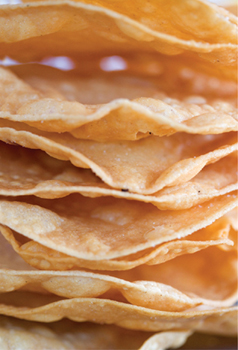
cindy’s backstreet tomatillo-avocado salsa
A few thoughts before you get started on the salsa: Look for avocados that are ripe but still firm—the ones on which the stem at the end still wiggles. Depending on the juiciness of your tomatillos, you may need a teaspoon or so more rice vinegar and a tablespoon of additional olive oil. A little ground cumin would be a nice addition, if you like. And finally, if you don’t want too much heat, remove the seeds from the jalapeño.
This salsa can be made up to a day ahead, though the fresher it is, the brighter it will be.
8 ounces tomatillos, papery husks removed, cut into ¼-inch dice
1½ avocados, pitted, peeled, and cut into ¼-inch dice
3 scallions, white and light green parts only, minced
1 jalapeño chile, stemmed, seeded if you wish, and minced
3 tablespoons minced cilantro leaves
½ teaspoon sea salt
¼ teaspoon freshly ground black pepper
½ teaspoon ground toasted cumin seeds (optional)
1 tablespoons rice vinegar
3 tablespoons olive oil
, combine all the ingredients except the vinegar and oil in a bowl. Mix well but gently, taking care not to mash the avocado. Whisk together the vinegar and oil until emulsified, and add just enough of this to the salsa to moisten it. Reserve any leftover vinaigrette to use in other salad dressings.
Tuna Tostadas with Watermelon and Tomatillo Salsas
Serves 6
These are so much fun. You can make them on mini tostadas (one to three inches in diameter) as well as on the regular four-inch rounds. If you want to do the cocktail-size ones, cook the tuna in one piece to medium-rare and slice it into bite-size pieces to fit the bite-size tostadas. Use number 1 grade yellowfin or ahi tuna, if possible.
As for the salsas, if you want them really spicy, don’t remove the seeds and membranes of the chiles. And if you have leftovers, either salsa would be great as a topping for scrambled eggs or a cheese omelette.
2 cups diced watermelon
2 cups watercress leaves
1 or 2 jalapeño, Fresno, or serrano chiles, stemmed and cut on the diagonal (seeds removed if you prefer less heat)
3 scallions, white and light green parts only, minced
Juice of 1 lime
2 to 3 tablespoons extra virgin olive oil
½ teaspoon salt
¼ teaspoon freshly ground black pepper
20 ounces tomatillos, papery husks removed
3 serrano chiles, stemmed and seeded
2 to 3 tablespoons peanut or olive oil
¼ onion, chopped
1½ teaspoons minced garlic
¼ bunch cilantro, leaves only
½ teaspoon salt
¼ teaspoon freshly ground black pepper
12 to 14 ounces tuna
Salt and freshly ground black pepper
Extra virgin olive oil, for brushing
6 small (4-inch) corn tortillas, fried until crisp
6 ounces feta cheese, crumbled
3 tablespoons toasted pumpkin seeds
1 lime, cut into wedges
, combine the watermelon, watercress, chiles, and scallions in a small bowl. In a second bowl, mix together the lime juice, olive oil, salt, and pepper. Reserve separately until needed. If you’re making this a long time ahead, refrigerate the watermelon, but give it time to come back to room temperature before you finish and serve it.
, put the tomatillos and serrano chiles in a pot with just enough water to cover. Bring to a boil and reduce to a simmer. Cook till just tender, 3 to 5 minutes, depending on how ripe your tomatillos are. In the meantime, heat the oil in a sauté pan and sauté the onion and garlic until translucent. Once
the tomatillos and chiles have softened, drain them and put them in a blender with the sautéed garlic, onion, cilantro, salt, and pepper. Blend until smooth. Strain if desired (we don’t), and set aside until needed.
, season the tuna to taste with salt and pepper and brush it lightly with olive oil. Sear it in a hot pan or grill over a hot fire until medium-rare. This should take 2 to 4 minutes, depending on the thickness of your fish and how hot your pan or grill is. In the meantime, reheat the beans. To finish the watermelon salsa, pour the lime and olive oil dressing over the watermelon and mix gently.
, smear the tostadas with black beans, then top them with some of the tuna and the watermelon salsa. Over that, spoon some tomatillo salsa, then sprinkle on the cheese and pumpkin seeds. Serve lime wedges on the side for squeezing.
Pacific Halibut Soft Tacos
Serves 6
I invented these fish tacos after a Valentine’s Day ferry ride to the San Francisco Ferry Plaza Farmers’ Market. I always try to limit myself to shopping just for our dinner, but no matter how many restraints I put on myself—you know, only one bag, just what I can carry in one hand (it’s amazing how much you can carry in one hand!)—I end up with enough food for several meals. On this occasion, one of the extras I just couldn’t pass up was some wonderful stone-ground tortillas from a great Sonoma vendor. They are thick and a bit chewy in just the right way. So the next day, I had the perfect use for the leftover roasted halibut from our Valentine’s Day dinner.
I like to serve this as soft tacos, on tortillas that are warmed in a hot skillet with no oil added. Of course, you could easily turn this dish into a tostada by frying the tortillas in a little oil until crisp.
2 tablespoons freshly squeezed lime juice
2 teaspoons Dijon mustard
¾ teaspoon ground cumin
¼ teaspoon salt
⅛ teaspoon freshly ground black pepper
6 tablespoons extra virgin olive oil
2 to 2½ cups roughly flaked cooked halibut (about 12 ounces)
3 tablespoons good-quality mayonnaise
1 scallion, white and light green parts only, minced
½ cup minced celery leaves and stalks
¼ cup chopped green olives (optional), or serve olives as a garnish
1 cup small arugula or other peppery green
1 cup cilantro leaves
6 small (4-inch-diameter) stone-ground corn tortillas
¼ cup plain yogurt
½ cup mild soft fresh goat cheese
1 avocado, thinly sliced
1 lime, cut into wedges
, combine the lime juice, mustard, cumin, salt, and pepper in a small bowl. Whisk in the olive oil in a slow steady stream, and continue whisking until well emulsified.
, combine the fish, 2 tablespoons of the vinaigrette, the mayonnaise, scallion, and celery in a bowl and mix gently. Do not break up the fish too much. If you’re using the chopped olives, add them now. In a separate bowl, mix together the arugula and cilantro, and toss them with just enough of the vinaigrette to coat.
, heat the tortillas over a gas flame or in a dry skillet until just warm and softened, keeping them warm under a kitchen towel as you go. Place the tortillas on
plates, spoon on a layer of the fish, and sprinkle with some of the salsa. Top this with a little mound of greens and a drizzle of yogurt. Finish by crumbling some cheese over all, and top with a slice or two of avocado. Serve with lime wedges. The way to eat these is to fold the taco in half and eat by hand; it can be messy, so have plenty of napkins on hand!
If you don’t have any leftover fish, it’s easy enough to roast a fillet of fish. Preheat the oven to 375°F. Remove any stray bones from the fillets, then sprinkle with sea salt and freshly ground black pepper, and drizzle liberally with olive oil. Roast for ten minutes per inch (so if your fillet is half an inch thick, roast for five minutes). Let it cool, then roughly flake the fish.
When I think burgers, I think of Sundays with my father. If we were good in church, my father would take us to the White Castle on Lake Street and order “sliders” for us. I can still picture it: we’d be munching on them, all dressed up in our Sunday best, with all that fried onion grease running down our arms.
We do a lot of mini burgers at the restaurant. They fit right in at Cindy’s Backstreet Kitchen with all the parties we do in our upstairs dining room. There are so many possibilities—different burgers, different buns, different dressings. And people love them. One Fourth of July, I did a “sliders” party: we made up trays of burgers, set out a huge spread of condiments and cheeses, and let everyone assemble their own mini burgers. It’s still being talked about, fifteen years later. Well, actually, the fact that I made the buns and biscuits from scratch is what’s still being talked about.
There are four burger recipes in this chapter. If you want tradition, try the
Sunday Supper Burgers. If you want a little heat, try the burgers with the
Roasted Chile Relish. And if you’re feeling adventurous, make the
Mini Duck Burgers with the Shiitake Mushroom Ketchup or the
Spicy Lamb Burgers.
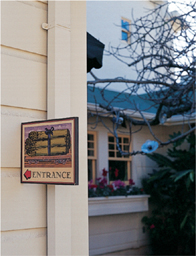

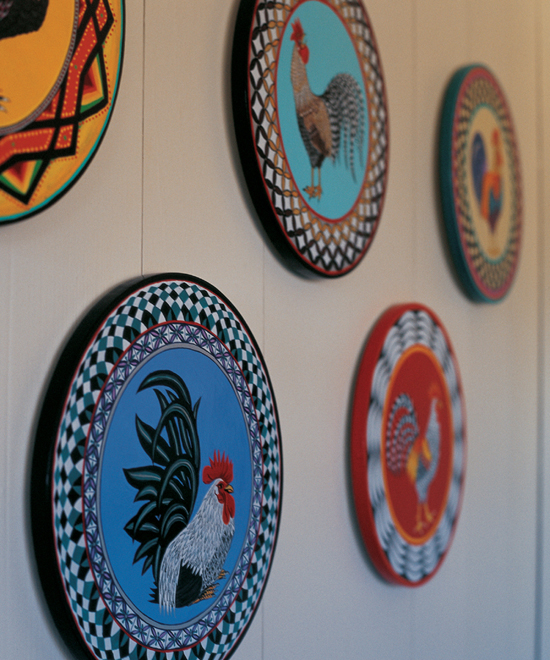
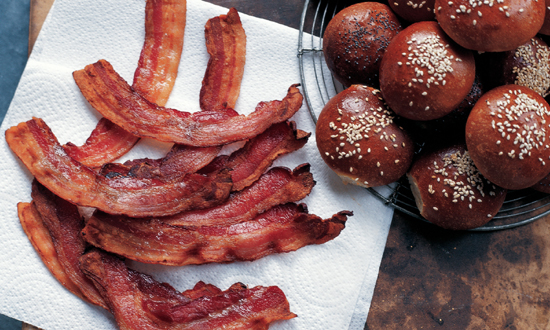

Sunday Supper Burgers with Thousand Island Dressing
Sunday Supper Burgers with Thousand Island Dressing
Serves 6
Whenever we have an open house or any other celebration, we serve these burgers, and they fly off the platters. I’ve heard talk that a person could eat about a hundred of them. The main reason for their popularity, I think, is that they are no-frills basic, and quite often, that’s what people really crave.
For the ground beef, get a high-quality organic meat, if possible, with about 18 percent fat content. The patties can be cooked in a dry skillet on the stove top or over a grill, grilling being my favorite method. As for the rolls, most bakeries have small rolls of some kind available: try different ones, or cut up some bagels. French bread cut into small squares makes great bite-size patty melts. Or go wild! Make your own tiny biscuits. (There’s an excellent recipe for Black Pepper Mini Biscuits.) Any extra Thousand Island Dressing can be used on a wedge of iceberg lettuce or a salad of romaine lettuce.
½ cup mayonnaise
¼ cup sweet pickle relish
2 to 3 tablespoons ketchup
3 or 4 drops Tabasco sauce
1 drop Worcestershire sauce
1 tablespoon chopped fresh parsley leaves
1 tablespoon cognac or brandy
2 strips applewood-smoked bacon
2 large onions
12 to 14 ounces ground beef
Salt
Freshly cracked black pepper
½ cup grated sharp Cheddar cheese
6 poppy seed brioche buns
1 cup whole arugula leaves
2 tablespoons minced pickles or 6 slices bread-and-butter pickle
1 tablespoon minced scallions
, combine all the ingredients and mix well. Cover and refrigerate until needed.
Cut the bacon crosswise into 1-inch strips. Cook the bacon until crisp, transfer to a layer of paper towels, and set aside. Slice the onions into ¼-inch-thick rings, and pick out the small rings in the center that will fit snugly on top of the little burgers. You’ll need a couple of rings per burger. Set these aside, too.
Form 6 small burger patties (they should take about ¼ cup of ground meat each) and season them with salt and pepper. Final preparation goes quickly, so line up everything you’ll need before you get started cooking—dressing, bacon, onion rings, cheese, buns, and so on. Cook the burgers over high heat, 1 minute on each side for rare, or longer if desired. Remove from the heat, and immediately pile a tablespoon of cheese on each burger. After the cheese melts, top each with a couple of onion rings.
While the cheese is melting on the burgers, cut the buns in half, toast them, and generously spread some dressing on the bottoms. Top with some arugula, then the burgers, and then some pickles. Finally, sprinkle on a spoonful of bacon and a few scallion bits, and close off with the bun tops.
Black Pepper Mini Biscuits
Makes 12
These two-inch-diameter biscuits are great for making mini burgers, tiny Sloppy Joes, or miniature chicken-on-a-biscuit rounds—all the familiar American dishes done small. They are best used fresh, but they can be reheated by placing them in a 300°F oven for a few minutes.
2 cups flour
1 tablespoon baking powder
1 teaspoon salt
½ teaspoon freshly ground black pepper
6½ tablespoons unsalted butter, chilled and cut into small cubes
¾ cup plus 1 tablespoon buttermilk
1 large egg
Preheat the oven to 400°F. Grease a baking sheet and set it aside.
Combine the flour, baking powder, ½ teaspoon of the salt, and the pepper in a food processor or a large mixing bowl. Work in the butter until the mixture resembles coarse meal, using short bursts of the food processor, the paddle attachment on a mixer, or a pastry blender if mixing by hand. Add the buttermilk and mix quickly, just until everything clumps together. Turn the dough out onto a smooth, lightly floured surface and finish it with a few pats of the hand. Roll the dough out to a ¾-inch thickness. Cut into 1½- or 2-inch rounds with a pastry cutter, and place the biscuits on the baking sheet. Gently press the scraps together, being careful not to overwork the dough, and cut out more biscuits.
Make a glaze by whisking the egg and the remaining ½ teaspoon of salt till frothy, and brush this over the biscuits. Bake until golden, about 12 to 14 minutes. Cool on a wire rack.
Mini Beef Burgers with Roasted Chile Relish and Pablo’s Pickled Onions
Mini Beef Burgers with Roasted Chile Relish and Pablo’s Pickled Onions
Serves 6
For better flavor, I recommend using ground beef that is not too lean: we use a local beef that is free of additives and has a ratio of 82 percent lean to 18 percent fat. If you use anything leaner, the burgers will be pretty dry and tasteless. I love the light lime-green of Anaheim chiles, so that’s what we use for the relish. They are not screaming hot, either. You can substitute a hotter chile if heat is what you want, or sweet bell peppers, if not. Just don’t skip the roasting and peeling step. It really makes a difference. You can make the relish a day ahead. And if you have any left over, it is great in egg dishes or mac and cheese or on bruschetta.
There’s nothing much to the pickled onions—just lime juice and the onions—but I love them for their bright pink color. The lime juice bleeds the red out of the outer layer of the onion and turns everything pink. These onions are often used in Mexican cooking to top off tostadas or quesadillas. The pickled onions can also be made a day ahead.
Vella Cheese produces many Monterey Jack cheeses, but my favorite for these burgers is the one called Original High Moisture Monterey Jack. It melts well and helps hold everything together. Other options would be a fontina, mild Cheddar, or buffalo mozzarella.
1 medium-size red onion, julienned
Juice of 1 lime
Tiny pinch of salt
2 Anaheim chiles, roasted and peeled
2 pasilla chiles, roasted and peeled
1 tablespoon extra virgin olive oil
1 scallion, white and light green parts only, minced
1 teaspoon minced fresh oregano leaves
6 sprigs cilantro, minced
Salt and freshly ground black pepper
1 pound ground beef
3 to 4 ounces soft Monterey Jack cheese
Salt and freshly ground black pepper
½ cup shredded iceberg lettuce
6 to 8 tablespoons butter, softened
6 sprigs cilantro
, combine the onions, lime juice, and salt in a ceramic or other nonreactive bowl and mix well. Cover and let sit a couple of hours at room temperature. The onions should become soft and turn a bright pink.
, tear the chiles into ¼-inch-wide strips and put them in a small bowl. In a separate bowl, combine the olive oil, scallion, oregano, minced cilantro, salt, and pepper, and mix thoroughly. Pour this mixture over the peppers and stir, making sure that all surfaces get nicely coated. Cover and put in the fridge at least 30 minutes.
Divide the ground beef into 6 or 12 portions, depending on what size buns you’re using, and form them into patties that will just about fit the buns. Cut the cheese into 6 or 12 squares. When you’re about ready to serve, season the burgers with salt and pepper, and cook in a large dry cast-iron pan over high heat, or on the grill. Cook to the desired doneness, about 1½ to 2 minutes each side for medium-rare. Put a square of cheese on top of each burger right after flipping them over.
Toast and butter the buns. Place some of the shredded iceberg lettuce on each of the bun bottoms and top with the burgers, cheese side up. Add some of the chile relish, then 1 or 2 slices of pickled onion. Finish with a sprig of cilantro and close off with the bun tops. You may want to use a sandwich pick to keep everything together.
Mini Duck Burgers with Shiitake Mushroom Ketchup and Chinese-Style Mustard Sauce
Mini Duck Burgers with Shiitake Mushroom Ketchup and Chinese-Style Mustard Sauce
Serves 6 to 8 (makes 16)
Here’s a great departure from the standard American hamburger—a duck burger on a sesame bun. You can buy ground duck meat or, if you have a meat grinder, you can grind it at home on a medium-size disk blade (you’ll need two ducks, about four pounds each). I use about 85 percent meat to 15 percent fat and skin. You should have pretty good luck finding sesame brioche buns at a local bakery, but if you have trouble and don’t feel like baking your own, any sesame seed bun you like would work as well. If the duck sounds good, but not as a sandwich, try serving it on a bed of arugula, lightly dressed with sesame vinaigrette and toasted sesame seeds.
As for the Shiitake Mushroom Ketchup, it was inspired by a dish my friend Annie Gingrass made for me one Christmas. It’s more like a vegetable condiment than a tomato ketchup, as it is much thicker. Any extra would be really good on beef burgers or scrambled eggs, or in fried rice or an Asian duck-and-noodle dish.
You’ll need one recipe of Mongolian Marinade, which you should prepare first. It goes into the duck burger mixture and the Shiitake Mushroom Ketchup, and is used to baste the burgers as they grill.
1 pound ground duck
1 scallion, white and a bit of the tender green, minced
1 teaspoon grated peeled fresh ginger
1½ teaspoons minced garlic
1 teaspoon salt
¼ teaspoon freshly ground black pepper
2 to 3 tablespoons olive oil
1 pound shiitake mushrooms, stemmed and quartered
1 onion, finely diced
½ teaspoon salt
½ teaspoon freshly ground black pepper
¼ cup balsamic vinegar
2 teaspoons minced garlic
2 tablespoons molasses
¼ bunch basil leaves, chopped
¼ cup sugar
2 tablespoons Colman’s mustard powder
1 large egg yolk
¼ cup red wine vinegar
6 tablespoons crème fraîche or sour cream
Additional Mongolian Marinade, for basting
16 small sesame brioche buns, split
1 to 2 tablespoons butter
2 cups arugula
Combine all the duck burger ingredients in a large bowl and mix well. Cover and chill for at least 1 hour and up to overnight. Meanwhile, prepare the ketchup and the mustard sauce.
, heat the olive oil in a large sauté pan over medium-high heat. Add the mushrooms and cook until tender. Add the onions and cook until they are translucent. Then add the remaining ingredients. Give the pan a good stir to make sure everything is evenly coated, reduce the heat, and simmer until the liquid is thick enough to coat the mushrooms, 3 to 5 minutes. Refrigerate, if you make this ahead, and warm it up before serving,
, combine the sugar and mustard powder in the top of a double boiler and mix with a whisk. Be sure to do this thoroughly, otherwise you will end up with lumpy mustard. When well combined, whisk in the egg yolk and vinegar. Cook over simmering water, stirring occasionally, 10 to 15 minutes, until the mixture is thick enough to form ribbons when drizzled from the spoon. Remove from the heat and allow to cool. When cool, fold in the crème fraîche. Keep refrigerated until needed.
, portion the chilled duck mixture out into 2-ounce (¼-cup) mini patties. Grill or griddle the patties over medium-high heat 2 to 3 minutes per side, basting with some of the marinade as you go. Toast and lightly butter the buns. Place the burgers on the bun bottoms, and top each with some shiitake ketchup, arugula, and a drizzle of the mustard sauce. Close off the sandwiches and serve with any extra mustard and ketchup on the side.
Spicy Lamb Burgers with Vietnamese Herb Salad and Tamarind Vinaigrette
Spicy Lamb Burgers with Vietnamese Herb Salad and Tamarind Vinaigrette
Serves 6
If you find lamb too rich and maybe too strong for your taste, give these burgers a try. The lamb burgers here are lightened and brightened by the addition of cilantro and mint to the patty mix, and if you want to lighten it even further, you can add some lime juice to it. To get it all just right, serve them with the cooling herb salad and tart-sweet tamarind vinaigrette.
Tamarind paste is the brownish-reddish pulp in the pod-shaped fruit of the tamarind tree: you can buy tamarind pods at Asian and Latin American markets and scrape out your own paste, but you can find jars or cans of prepared tamarind paste there, too. Tamarind has a pleasant sweetsour taste and is very commonly used in cooking throughout Southeast Asia, India, Africa, South America, and the Caribbean. Even if you’ve never used tamarind yourself, you’ve probably had a taste of it somewhere along the line, as it is used commercially to flavor candies, jams, chutneys, and soft drinks.
Oyster sauce is a Chinese condiment, used as a dip and in stir-fries and marinades. The best brands come from Hong Kong, but you may find domestic brands right in your local supermarket. Once opened, the container should be refrigerated. If you can’t find oyster sauce but have some hoisin sauce, use that instead. It’s different but nice.
These brightly flavored burgers are best cooked over a charcoal or wood fire, but they can be seared instead in a cast-iron pan, or cooked under an oven broiler. Maxine, one of my testers, set off her smoke alarm broiling her burgers in the oven, though, so you might want to start up the grill.
4 tablespoons brown sugar
3 tablespoons water
2 tablespoons tamarind paste
1 tablespoon soy sauce
6 tablespoons olive oil
5 cloves garlic, minced
1½ tablespoons oyster sauce
½ serrano or jalapeño chile, seeded and minced
2 tablespoons chopped fresh mint leaves
1½ tablespoons minced cilantro leaves
½ sweet onion, minced
Juice of ½ to 1 lime (optional)
1 pound ground lamb
2 scallions, white and light green parts only, cut into 1½-inch julienne
2 Thai or serrano chiles, seeded and julienned
½ bunch basil, any kind, small leaves only
¼ bunch cilantro, leaves only
¼ bunch mint, small leaves only
½ bunch chives, cut into ½-inch pieces
1 bunch ancho cress or watercress, leaves only
, combine the sugar and water in a small sauté pan. Cook over medium heat, stirring, until the sugar has dissolved. Add the tamarind and soy sauce, and stir until smooth. Remove from the heat and whisk in the olive oil. Reserve until needed.
, first combine the garlic, oyster sauce, chile, mint, cilantro, onion, and lime juice, if desired, in a large bowl and mix well. Then mix in the ground lamb meat, making sure everything is well combined. Divide the mixture into 6 equal parts, or 12 if you want to make mini patties. Moisten your hands with water before forming the patties, as this makes it easier. Shape the patties with the palm of your hand more than your fingers, and make them flat but not too thin: ½ to ¾ inch thick is ideal, otherwise the burgers will overcook before they caramelize nicely. Regular patties should be 2 to 3 inches in diameter, minis about 1½ inches.
, cook the burgers to the desired doneness, about 1½ minutes per side for rare, 2 minutes for medium. Combine all the ingredients for the salad and toss it with just enough of the vinaigrette to coat. Serve the dish with the salad piled alongside or on top of the lamb patties and an extra drizzle of the vinaigrette over all.
Fried Green Tomatoes with Spicy Rémoulade
Serves 6
Make sure the tomatoes you use for this dish are nice and hard, with no hint of ripening. You want that firm crispness and tart taste to contrast with the rich creaminess of the rémoulade. Don’t use the special green variety of heirloom tomatoes, as it remains green even when it’s fully ripe, which could lead to some confusion.
Think of a rémoulade as a dressed-up mayonnaise, and feel free to play around with the recipe given here. A classic French rémoulade is made with tarragon and cornichons and a French coarse-grained mustard. Long ago, the Creole cooks in New Orleans modified the French-style rémoulade by using finely chopped sweet or dill pickles instead of the cornichons, and minced green onions instead of tarragon. But the biggest change was to use Creole mustard, which is much spicier than the French mustard. If you want to experiment with that, try Zatarain’s Creole mustard. It’s my favorite. The rémoulade below has capers instead of pickles.
Plan on one or two half-inch slices of tomato per person, depending on how many other dishes you are making. For something a little more substantial, make a sandwich with a couple of slices of fried green tomatoes, a big dollop of rémoulade, and some shaved lettuce. To make it even more filling, tuck a slice of buffalo or other fresh mozzarella between the slices of fried tomatoes. If you have extra rémoulade, it would be great in a potato salad.
1 cup mayonnaise
1 tablespoon Dijon or Creole mustard
1 scallion, white and light green parts only, minced
1 tablespoon capers, rinsed and minced
2 tablespoons minced fresh tarragon or chervil
2 tablespoons minced fresh parsley leaves, rinsed and squeezed dry
½ teaspoon freshly ground black pepper
1 cup watercress, trimmed of coarse stems
2 cups small-leaved arugula, preferably Italian wild rucola
2 tablespoons balsamic vinegar or aged sherry
½ clove garlic, smashed and minced
¼ teaspoon dried crushed red pepper
Salt and freshly ground black pepper
6 tablespoons extra virgin olive oil
3 or 4 large hard green tomatoes
1 cup flour
1 cup panko
2 large eggs
Olive oil or vegetable oil, for frying
, combine all the ingredients and mix well. Cover and refrigerate until needed.
Combine the watercress and arugula in a mixing bowl, and set it aside. To make the dressing, combine the vinegar, garlic, crushed red pepper, salt, and pepper. Stir until the salt has dissolved, then gradually whisk in the oil. Whisk until well emulsified. Set aside until needed.
, core them and cut them crosswise into ½-inch-thick slices. Place the slices on a tray or in a casserole dish, and sprinkle them on 1 side with 1 teaspoon of salt to draw out excess moisture. Let them rest undisturbed for 30 minutes, then blot them with clean kitchen or paper towels.
Put the flour in a shallow bowl, and combine it with 1 teaspoon of salt and ½ teaspoon of pepper. Put the panko on a small plate. Beat the eggs in another shallow bowl, and set that between the flour mixture and the panko. Dredge the tomatoes in the flour mixture and shake off the excess. Dip immediately in the eggs, drain, and dip in the panko, pressing firmly to coat. Let the tomatoes rest, not touching them, for 20 minutes or so.
, preheat the oven to 200°F and heat ¼ inch of oil in a skillet over medium-high heat. When the oil is hot but not yet smoking, add some of the tomatoes, being careful not to overcrowd the pan. Fry until golden brown and crisp on the bottom, then turn them over and repeat. About 2 minutes on each side should do. Drain the tomatoes on a baking sheet lined with paper towels. Keep in the warm oven while you fry the remaining slices.
If you’re arranging the tomatoes on a large platter, they’ll look best on an oval one. Toss the greens with just enough of the dressing to coat them lightly, and put the greens on the platter first. Tuck tomato slices into the greens, and put a dollop of rémoulade on each slice. Pass additional rémoulade for your guests to help themselves. For individual servings, put 1 or 2 tomato slices in the center of each small plate, and top with ½ tablespoon or so of rémoulade. Toss the greens with the dressing, and sprinkle them around the tomatoes.
Cindy’s Supper Club Escargots
Serves 6
At Cindy’s Backstreet Kitchen, we do a monthly event called Cindy’s Supper Club. It’s held in one of our upstairs dining rooms, and we do a set menu with selected wines. We always try to have a course or two that people don’t usually order, like this one, which has converted many non-snail-eaters. The idea for this dish came from a wonderful braised pork and snail stew that Paula Wolfert makes. We serve our version over half-inch-thick slices of baguette that have been grilled. A few other excellent ways to serve this would be over smaller croutons or—seasoned with a touch of grated Parmesan cheese—over soft polenta or grits. It would even be good over pasta.
6 half-inch-thick slices baguette or bâtard, sliced on the diagonal
2 tablespoons olive oil, plus additional for brushing
6 to 8 paper-thin slices Serrano ham or prosciutto, julienned
¼ cup red wine
2 shallots, thinly sliced
6 cloves garlic, thinly sliced
1 large tomato, peeled and diced, or ¾ cup canned diced tomatoes
1 to 1 ½ cups chicken stock
2 to 3 tablespoons butter
1 to 1½ ounces dry sherry, Pernod, or Ricard
18 large canned snails, halved
1 tablespoon finely chopped fresh thyme leaves
2 tablespoons chopped fresh parsley leaves
Salt and freshly ground black pepper
, lightly brush the bread slices on each side with olive oil and toast over a grill or on a baking sheet in a 375°F oven until crispy and golden on the outside, but still a little soft in the center.
, heat the 2 tablespoons of oil in a large sauté pan over medium-high heat. Add the ham and sauté till it is well heated through and just a touch caramelized. Add the wine and deglaze the pan. Add the shallots and half the garlic; cook 1 to 2 minutes, until translucent. Add the tomato and continue cooking, stirring, till the liquid in the pan has almost completely evaporated. Add the stock and cook till reduced by half. The dish can be made a bit ahead to this point, and set aside.
Just before serving, heat the sauce over medium-high heat, bringing it to a simmer, and add the remaining garlic along with the butter, sherry, and snails. Reduce the heat to medium, add the herbs, season with salt and pepper, and cook till emulsified, 1 to 2 minutes. Take care not to boil the snails, as they will become tough if you do. To serve, lay out the toasted bread in the center of 6 small soup plates, and spoon the snails and sauce over all.
Smoked Salmon with Curried Egg Salad and Rye Toasts
Smoked Salmon with Curried Egg Salad and Rye Toasts
Serves 6
My niece Aimee, who is also one of our recipe testers, says these make the best Sunday football snack. One of the tricks to them is not to overcook the eggs: the yolks should be just set. If you absolutely must have harder-cooked eggs, add a minute or two to the cooking time.
Try to get salmon that has been smoked over alder wood, as it is the most flavorful. If you can’t find nice sliceable smoked salmon of any kind, smoked trout will work, too. Just don’t use lox.
2 jumbo eggs
1 teaspoon salt, plus a pinch more for the egg salad
1 small center rib of celery with leaves, finely minced
1 scallion, white part only, finely minced
½ red Fresno chile, seeded and finely minced
1½ teaspoons Indian (not Thai) curry paste
1½ teaspoons finely minced fresh dill weed
2 or 3 drops freshly squeezed lemon juice
1 or 2 drops Tabasco sauce
1 to 1½ tablespoons mayonnaise, preferably homemade
12 thin 2-bite-size slices of European-style rye bread
Olive oil, for coating
12 paper-thin slices of smoked salmon
1 Japanese cucumber, finely minced
Coarsely ground black pepper
, put them in a small pot with enough water to cover, and add 1 teaspoon of salt. Bring the water to a boil, reduce the heat to a strong simmer, and cook the eggs for 7 minutes. Run them under cold water till cool, or put them in an ice bath.
, peel and finely chop the eggs (I often grate eggs using a box grater held over a bowl). Put the eggs in a small mixing bowl along with the celery, scallion, chile, curry paste, dill, lemon juice, Tabasco, 1 tablespoon of mayonnaise, and a pinch of salt. Mix gently but thoroughly, using a fork. If the mixture seems too dry, add a little more mayonnaise. You can make the egg salad ahead, and chill it until needed.
, preheat the oven to 375°F. Brush both sides of the bread with olive oil and toast until crisp.
, spread 1 to 2 tablespoons of egg salad on each toast and top with a piece of salmon. Finish with a sprinkle of cucumber and coarsely ground black pepper.
Roasted End o’ Summer Tomatoes with Red Wine–Honey Vinaigrette
Serves 6
You can make this with any variety of tomato, but be sure they are really tasty. Roasting will intensify and sweeten the flavors, but you can’t expect much if you start with bland tomatoes. If you want to have a little fun with this, buy two different colors of tomatoes, and roast them separately. It will make very colorful bruschetta.
For the cheese, you want something with sharp, bright flavor to contrast with the richness of the roasted tomatoes. Some of my favorites are Cabrales, Valdeón, or Picón, which are all blue cheeses from Spain; or Laura Chenel’s aged Crottin, Ig Vella’s dry-aged Monterey Jack, or Bellwether Farms’ pecorino. I’ve even done it with crumbled feta cheese. This recipe will give you a chance to experiment (or to use up leftover cheese).
The vinaigrette is more like a sauce than a salad dressing. It is cooked, which smooths it out, sweetens it, and keeps it from “fighting” with any table wine you might be serving with the meal. I’ve been using a French red-wine vinegar called vinaigre de Banyuls. It is made from Grenache grapes, so it has some fruit and lightness, and isn’t thick or super-rich. Like balsamic vinegar, vinaigre de Banyuls undergoes a long aging process. You can find it at specialty gourmet shops.
2 tablespoons red wine
2 tablespoons red wine vinegar
½ tablespoon honey
⅛ teaspoon salt
Pinch of freshly ground black pepper
1 tablespoon Dijon mustard
¾ cup extra virgin olive oil
2 pounds vine-ripened tomatoes
1 Maui or other sweet onion, cut into wedges
1 tablespoon chopped fresh oregano
2 tablespoons extra virgin olive oil
½ tablespoon sea salt
¼ to ⅓ teaspoon freshly ground black pepper
6 half-inch-thick slices rustic country, sourdough, or semolina bread
1 cup arugula leaves
1 tablespoon minced chives
½ cup crumbled blue cheese or goat cheese
Minced fresh oregano, for garnish
, combine the red wine, red wine vinegar, and honey in a small pot. Bring to a boil, lower the heat to a strong simmer, and reduce by half. Allow to cool to room temperature, then add the salt, pepper, and mustard; whisk till the salt dissolves. Add the olive oil in a slow steady stream, whisking all the while. Whisk till well emulsified and set aside. This can be done up to 4 hours before serving.
Preheat the oven to 425°F. Peel and core the tomatoes, then quarter them and remove the seeds. Gently mix together the tomato, onion, chopped oregano, oil, sea salt, and pepper. Spread this mixture out in an even layer in a large ceramic baking dish. A Spanish earthenware dish called a cazuela would work well. Roast, stirring occasionally, until the juices from the tomatoes have evaporated and the edges of the vegetables have caramelized well, 15 to 20 minutes. The tomatoes should reduce to a very concentrated, chunky puree.
, toast or grill the bread, and toss the arugula and the chives with the vinaigrette. Smear the tomatoes liberally on the toasts. Sprinkle the greens over the tomatoes, crumble on some cheese, and finish with a sprinkle of minced oregano.
Roasted Peppers with Anchovies and Capers
Roasted Peppers with
Anchovies and Capers
Serves 6 to 8
I am a roasted pepper junkie. I love them in all their colors, even the green ones, and use them with abandon on just about whatever will hold still long enough for me to plop them on. The best way to roast peppers is over a wood fire. It gives them far superior flavor. I can’t count how many times over the past twenty-two years people have told me how good the food tastes at Mustards because it’s cooked over a wood fire. I will never understand the idea of outdoor gas grills. You might as well just cook in the kitchen! So I always roast peppers over a wood fire unless there’s an absolute downpour, and then I’d do it over the gas stove burner or under a broiler.
The very best anchovies of all are the salt-packed anchovies from Italy and Spain. They are shipped in large cans, but if you live in a large city, there’s probably a specialty store there where you can buy just what you need. Soak and rinse well before using. If you can’t get the salt-packed ones, buy the oil-packed anchovies that come in glass jars. That way you can be sure of what you are getting. I have never found a good anchovy paste, and I don’t recommend that as a substitute.
3 red bell peppers
3 yellow bell peppers
2 ounces anchovies, plus additional for garnish (optional)
1 handful fresh basil leaves
Pinch of fresh oregano leaves, finely chopped
3 cloves garlic, minced
2 tablespoons capers, rinsed
Sea salt (Maldon flake, if possible)
Freshly ground black pepper
1 tablespoon extra virgin olive oil, plus additional for brushing
12 to 16 slices bread (3-inch-long ovals or rectangles)
Roast the peppers till nicely blackened all over, then pop them into a plastic bag or put them in a bowl and cover it tightly. When the peppers are cool enough to handle, peel off the blackened skin and remove the stem, seeds, and membranes. Tear the peppers into strips over a mixing bowl so as not to lose any of their juices, and drop them into the bowl.
Chop the anchovies really finely, then smash them into a paste with the side of the knife blade. Add this to the bowl of bell peppers. Shred the basil by hand (don’t use a knife, as the basil will turn black). Add this to the bowl, too, along with the oregano, garlic, capers, salt, pepper, and the 1 tablespoon olive oil. Set aside until needed (this will hold up to 2 hours).
, preheat the oven to 375°F. Brush the bread on each side with olive oil, place on a baking sheet, and toast in the oven till crispy and golden. (If you have the grill fired up, you can toast the bread on the grill instead.) Pile a nice amount of the bell pepper mix on each crouton, and sprinkle gingerly with additional sea salt and freshly ground black pepper. If you like, top each off with a half fillet of anchovy as a garnish.
Wilted Winter Greens on Bruschetta
Serves 6 to 8
You may be surprised to know that chard comes in a variety of colors, including red, pink, orange, and yellow (the color is in the stalks, not in the leaves). There is even a rainbow chard, which has stalks of five different colors on each plant. The taste differs little from variety to variety, so if you can’t find red or rainbow chard, you can use regular green Swiss chard, and substitute white wine or vermouth for the red wine in the recipe. In preparing this dish, be sure to wash all the greens very well: nibble on a leaf or two to make sure they’re clean, as even the tiniest bit of dirt or sand will ruin it.
If you want to be fancy, you can fry the capers in one or two tablespoons of olive oil until crisp and drain them, then sprinkle them on top at the end as a garnish. If you don’t care for capers, you can sprinkle on Parmesan or an aged goat or Monterey Jack cheese as the topping instead.
Another great way to serve the greens would be to toss them with pasta or spoon them over polenta or risotto. Mascarpone would be a wonderful addition to the polenta alternative.
3 or 4 half-inch-thick slices rustic country bread or bâtard
Butter or olive oil, for coating
1 bunch red or rainbow chard
8 ounces other tender greens, such as Japanese red mustard, turnip, or beet greens
3 or 4 tablespoons olive oil
½ medium onion, finely diced
1 small leek, white and light green parts only, sliced into thin circles and rinsed
2 cloves garlic, finely minced
¼ cup red wine
¼ cup chicken or vegetable stock or water
Salt and freshly ground black pepper
1 teaspoon crushed dried red pepper
1 tablespoon chopped fresh mint or thyme (not both)
1 tablespoon capers
, preheat the oven to 375°F. Cut the bread slices in half. Coat both sides with butter or olive oil, place on a baking sheet, and toast in the oven until just starting to turn golden. You want the bread to be crispy on the outside but still tender and chewy in the middle. Grilling the toasts would be extra-good if you happen to have one going.
Wash all the greens thoroughly. Working with the chard first, pull the leaves from the stems, tear them into large pieces, and set them aside. Finely julienne the stems crosswise, and keep them separate from the leaves. Tear up the other tender greens into large pieces, and add them to the chard leaves. Heat the olive oil in a large saucepan over medium heat and add the onion and leek. Cover and let cook for 3 to 5 minutes, stirring a couple of times. Add the chard stems and garlic, stir again, then cover and cook several minutes longer, until tender. Remove the lid and reduce the liquids. When the ingredients begin to caramelize, add the wine and cook till dry. Add the chard leaves, the other greens, and the stock; cook, covered, another minute. Remove the lid and continue to cook, stirring, till all the greens are wilted and tender and almost all the liquid has evaporated. Season to taste with salt and pepper. Stir in the crushed red pepper, chopped mint or thyme, and capers. Serve mounded on the bruschetta.
